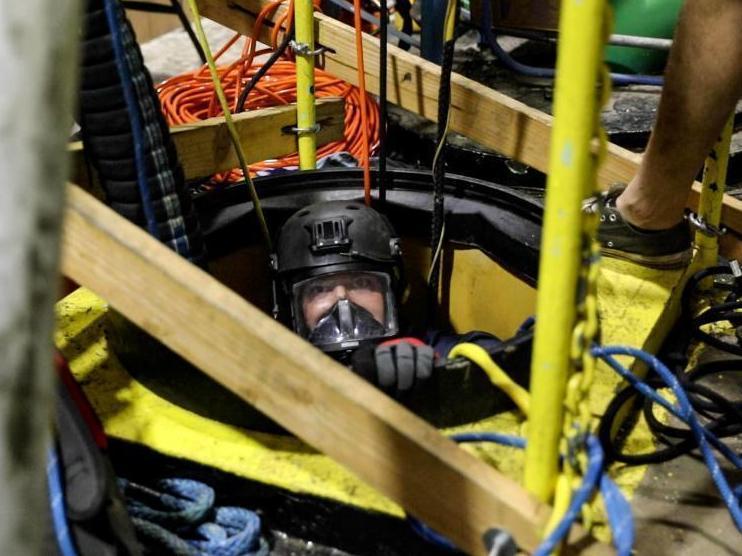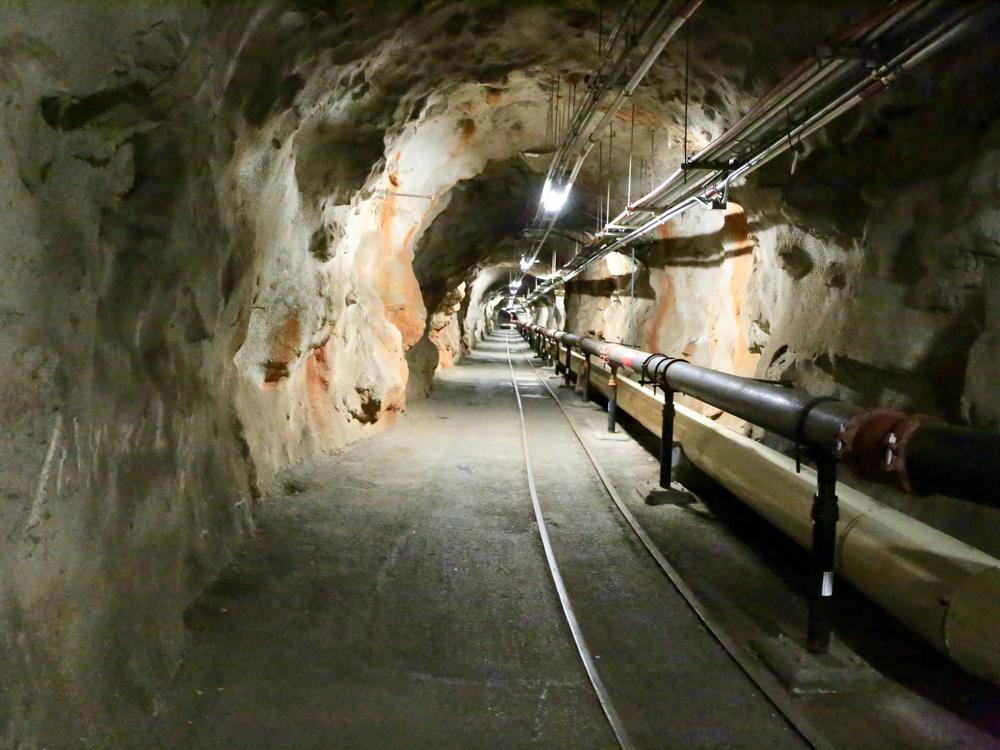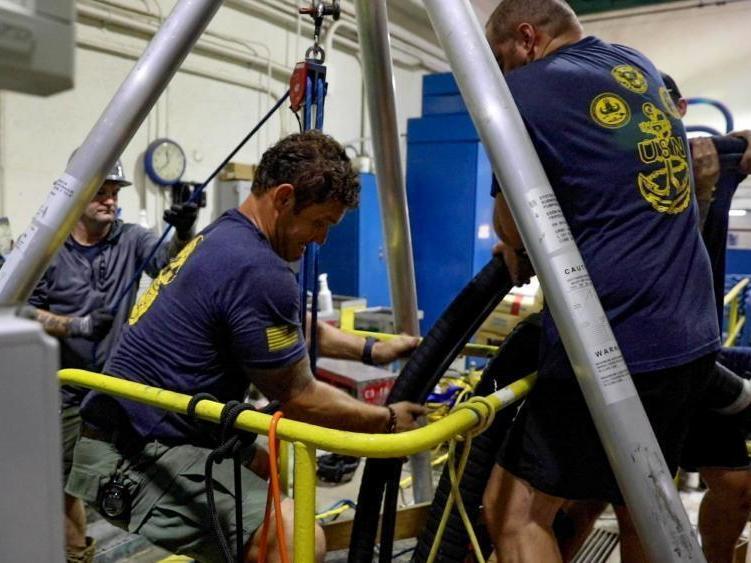Section Branding
Header Content
Thousands displaced from Oahu military base due to contamination in Navy water system
Primary Content
Last week NPR reported that Hawaii had ordered the U.S. Navy to halt operations at the World War II-era Red Hill Bulk Fuel Storage Facility after a petroleum leak was found to have contaminated Honolulu's drinking water supply.
We've since learned that samples from the Red Hill Shaft contained petroleum levels that were 350 times the level considered safe, and that some 3,000 military members and their families have been relocated to temporary housing.
The Navy says it's found the source of the gas leak, but state officials and environmental activists are still calling for the facility to be permanently shut down.
Here's a look at the context and latest developments:
It's the latest in a string of fuel leaks at Red Hill
The Red Hill Bulk Fuel Storage Facility, which was constructed in the early 1940s, consists of 20 steel-lined tanks mined inside a volcanic ridge near Pearl Harbor and can hold up to 250 million gallons of fuel.
The tanks sit above an aquifer that supplies a quarter of the water consumed in urban Honolulu. The site is also about a mile away from the Honolulu Board of Water Supply's Halawa Shaft, which provides 20% of the drinking water for the region.
The facility had two major fuel leaks this year alone, and in October received a $325,000 state fine for maintenance and operations violations. Many residents, officials and environmental advocates have long considered the leak-plagued facility an "inevitable environmental and public health disaster," as the Honolulu Civil Beat reports.
The Red Hill water shaft is one of three sources that feed into the Navy's Joint Base Pearl Harbor-Hickam water system, which includes military housing and two elementary schools. The Navy's water system serves some 93,000 residents.
The troubles began right after Thanksgiving
The state health department first began receiving reports of a "fuel or gasoline-like oder" from water system users in late November. The Associated Press reported a week later that nearly 1,000 military households had complained about the tap water, and some people said they experienced cramps and vomiting after drinking it.
The Navy initially dismissed those concerns, with the joint base commander originally telling families that the water was safe to drink (he has since apologized). Health officials said on Nov. 30 that they would investigate the complaints, and urged those on the base to avoid drinking, cooking with it or using it for oral hygiene.
Within days, the health department said a preliminary analysis had detected petroleum products in water samples from one of the sites where odors were reported, and the Navy separately said it had detected petroleum products in the Red Hill well.
Health officials said on Dec. 10 that additional samples from the Red Hill shaft contained "total petroleum hydrocarbons diesel range organics" 350 times that of levels deemed safe for drinking water. They also tested positive for "gasoline range organics" at more than 66 times the safe level.
The Navy contested Hawaii's order to halt operations
On Dec. 7, the Hawaii Department of Health ordered the Navy to suspend operations at the facility and move toward defueling its underground storage tanks, as well as take immediate steps to install a drinking water treatment at the Red Hill Shaft and submit a work plan to assess system integrity.
The Navy informed state officials that it would be contesting the order, even though it had paused operations at the complex — which supplies fuel to U.S. military ships and aircraft that patrol the Pacific — since Nov. 27.
On Dec. 8, Secretary of the Navy Carlos Del Toro said he had directed the pause of all operations at the Red Hill Underground Storage Tanks until the investigation into the source of the petroleum leak is completed (but did not mention defueling the tank, as the order directs).
He also said the Navy will "evaluate the acquisition of a drinking water treatment system and consult a qualified independent third party to assess operations and system integrity" of the facility.
"We are aiming for a new normal: One where this never happens again," he said in a statement. "The Department is determined and committed to making the necessary changes. We can and will take care of our people, while also preserving and protecting our national security interests in the Pacific and at home."
Hawaii Public Radio reported on Tuesday that Hawaii's chapter of the Sierra Club filed a motion to intervene in the state's proceedings for the emergency order. A lawyer for Earthjustice, the environmental law firm representing the group, said the move puts pressure on the health department to ensure the Navy follows the terms of the order.
Navy officials say a jet fuel spill is to blame
Adm. Samuel Paparo, the commander of the U.S. Pacific Fleet, told state lawmakers on Friday that the Navy had determined the source of the water well contamination as jet fuel from a Nov. 20 spill near the storage facility.
"So from the test results and engineering analysis that we've done today, it appears some quantity of JP-5 jet fuel entered the Red Hill well in a single event, likely from the Nov. 20 spill, and then subsequently pumped from that well and distributed throughout those portions of our Navy's water distribution system," he said, according to Stars and Stripes.
Rear Adm. Dean VanderLey, head of Naval Facilities Engineering Systems Command Pacific, outlined a timeline for cleanup at that same briefing.
In the immediate term, he said the Navy is working with state health officials to directly pump out any petroleum that is floating on top of the well water.
He said the first step is to "flush a full-system volume of clean water" — or about 25 million gallons — through the distribution system, which would take a minimum of four days. The next phase involves flushing every home and facility individually.
VanderLey said the goal is to finish the process and have people back in their homes by Christmas.
The crisis' impact is being felt on and beyond the base
Meanwhile, thousands of affected base residents have been relocated to temporary housing.
U.S. Secretary of Defense Lloyd Austin said in a statement this week that more than 3,000 people had been displaced from their military housing and are living in hotels, and "thousands" have been evaluated by medical staff. More information for those impacted is available here.
"We take this very seriously," Austin added. "And I am personally monitoring our progress and our mitigation efforts. Indeed, Navy leadership updates me daily on the measures they are taking to care for affected military personnel and families, to restore the safety of the water system in military housing, and to coordinate with local authorities – in particular the Hawaii State Department of Health – about the best way forward."
Austin said he expects military leaders in Hawaii to do all they can to get residents back in their homes safely and quickly, and praised their efforts to date, which include establishing a Pregnancy Medical Advice hotline, delivering more than 150,000 gallons of potable water and flying additional water filtration systems to the island.
He also directed Deputy Secretary of Defense Kathleen Hicks to visit the fuel storage facility this week and meet with local officials, residents and experts.
There are concerns that the leak could impact civilian water supply, too.
The state's Board of Water Supply said in early December that it had to shut down the Halawa Shaft as a result of the contamination at the Red Hill well. A report released this week found no contaminants in the water, but officials still have questions about whether that might change and when it might resume service.
Hawaii's congressional delegation has repeatedly asked Gov. David Ige to request an emergency declaration from President Biden, though he told Hawaii Public Radio last week that the situation is complicated because it involves federal property. Listen to the interview here.
This story originally appeared on the Morning Edition live blog.
Copyright 2021 NPR. To see more, visit https://www.npr.org.



